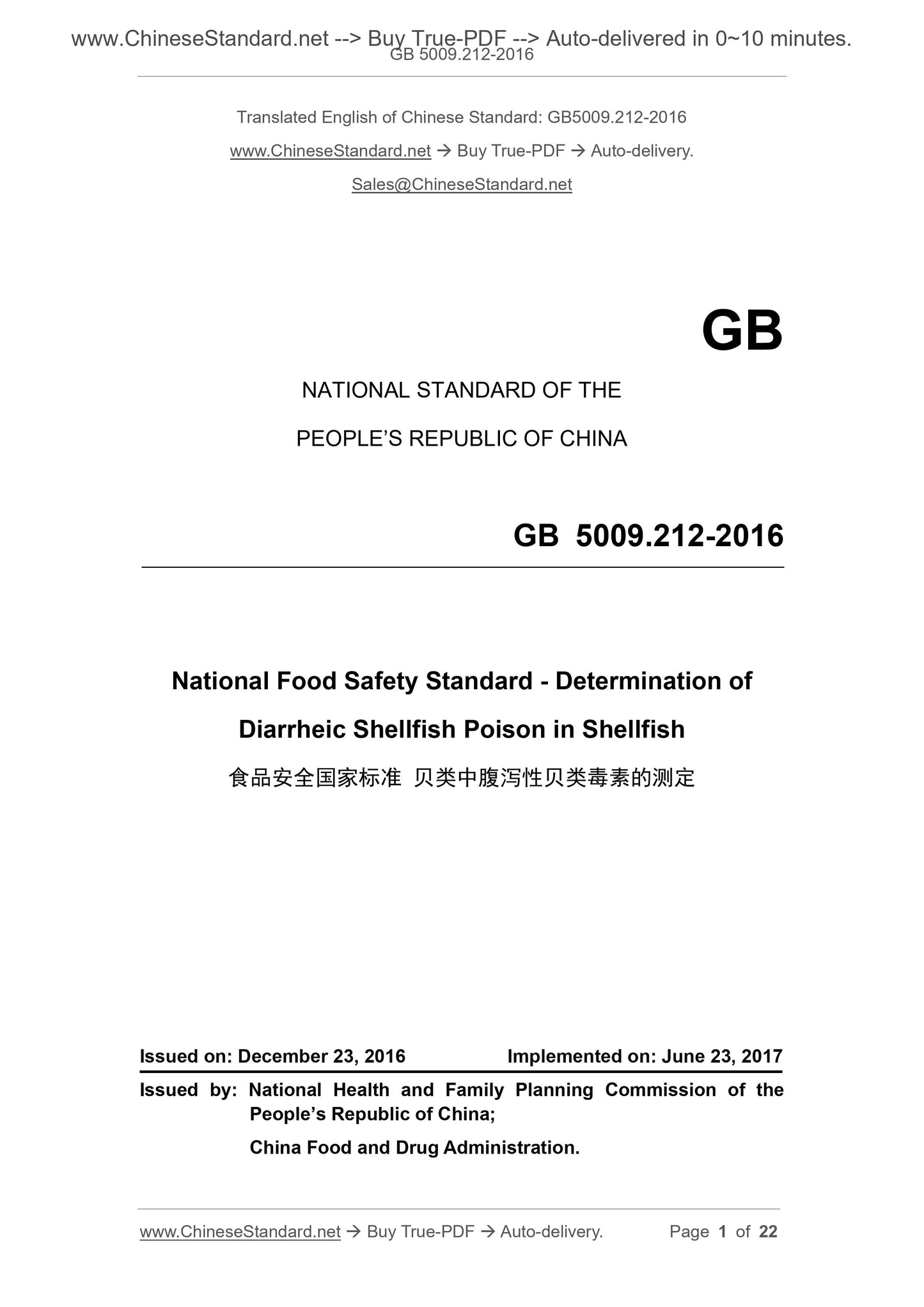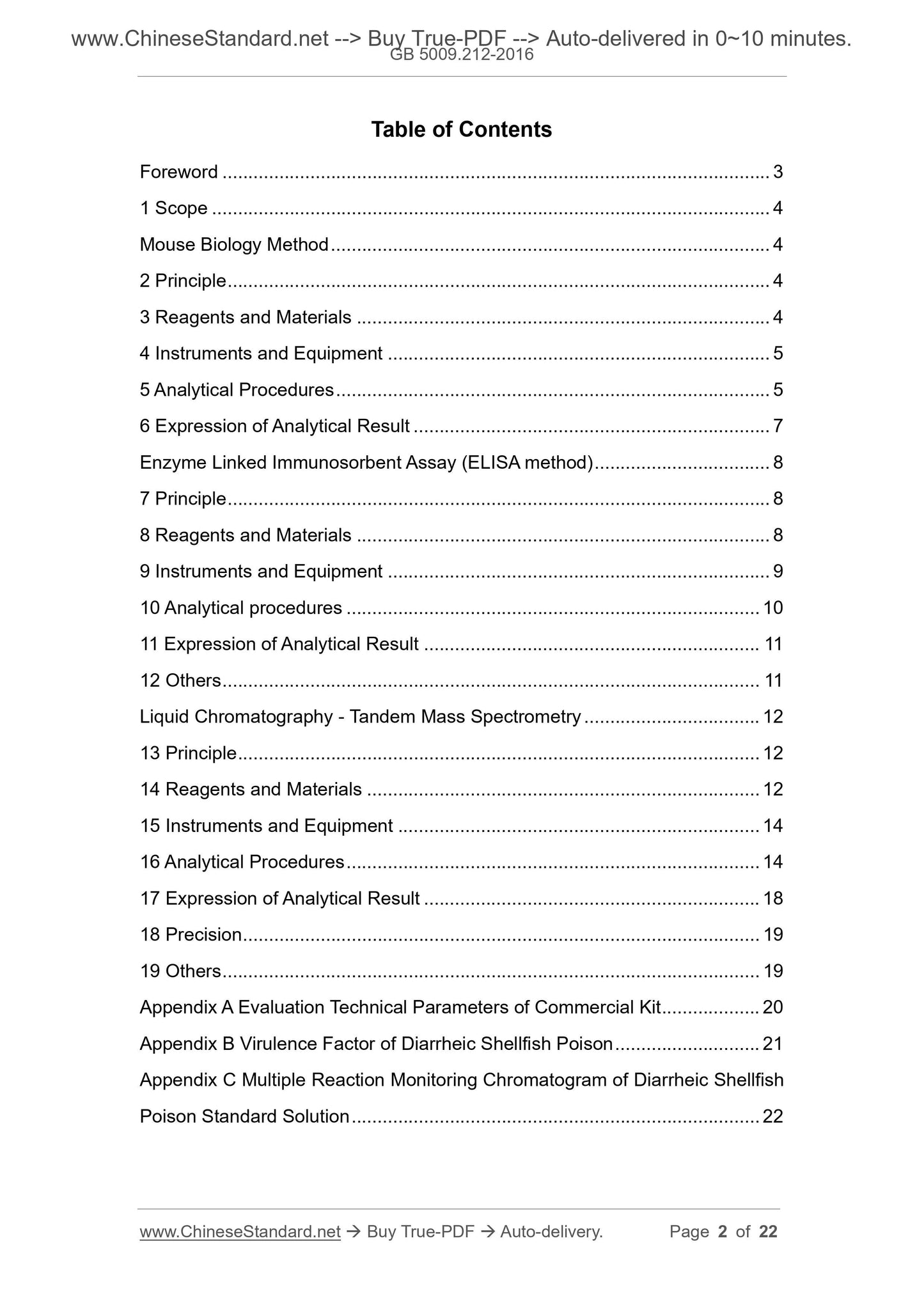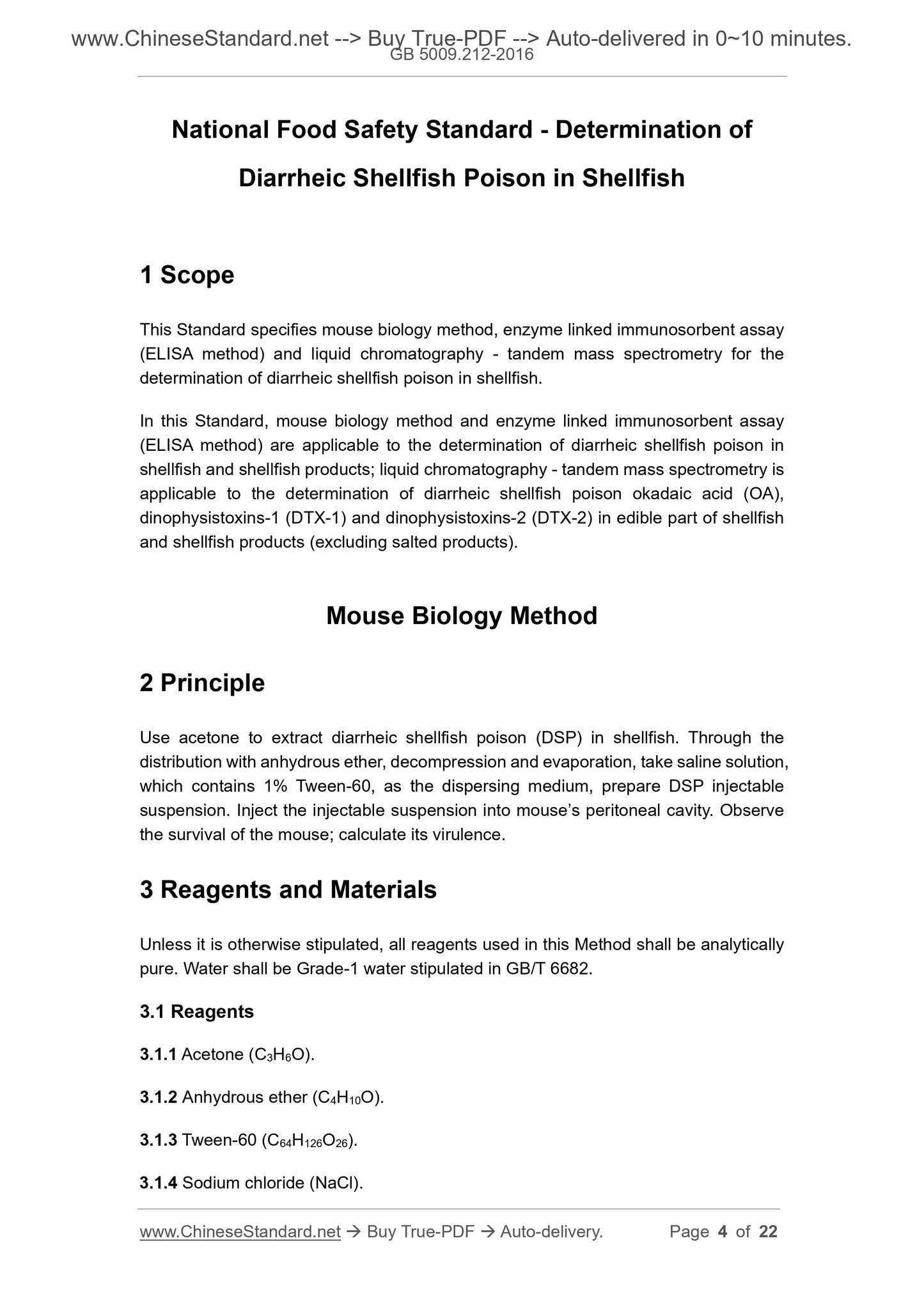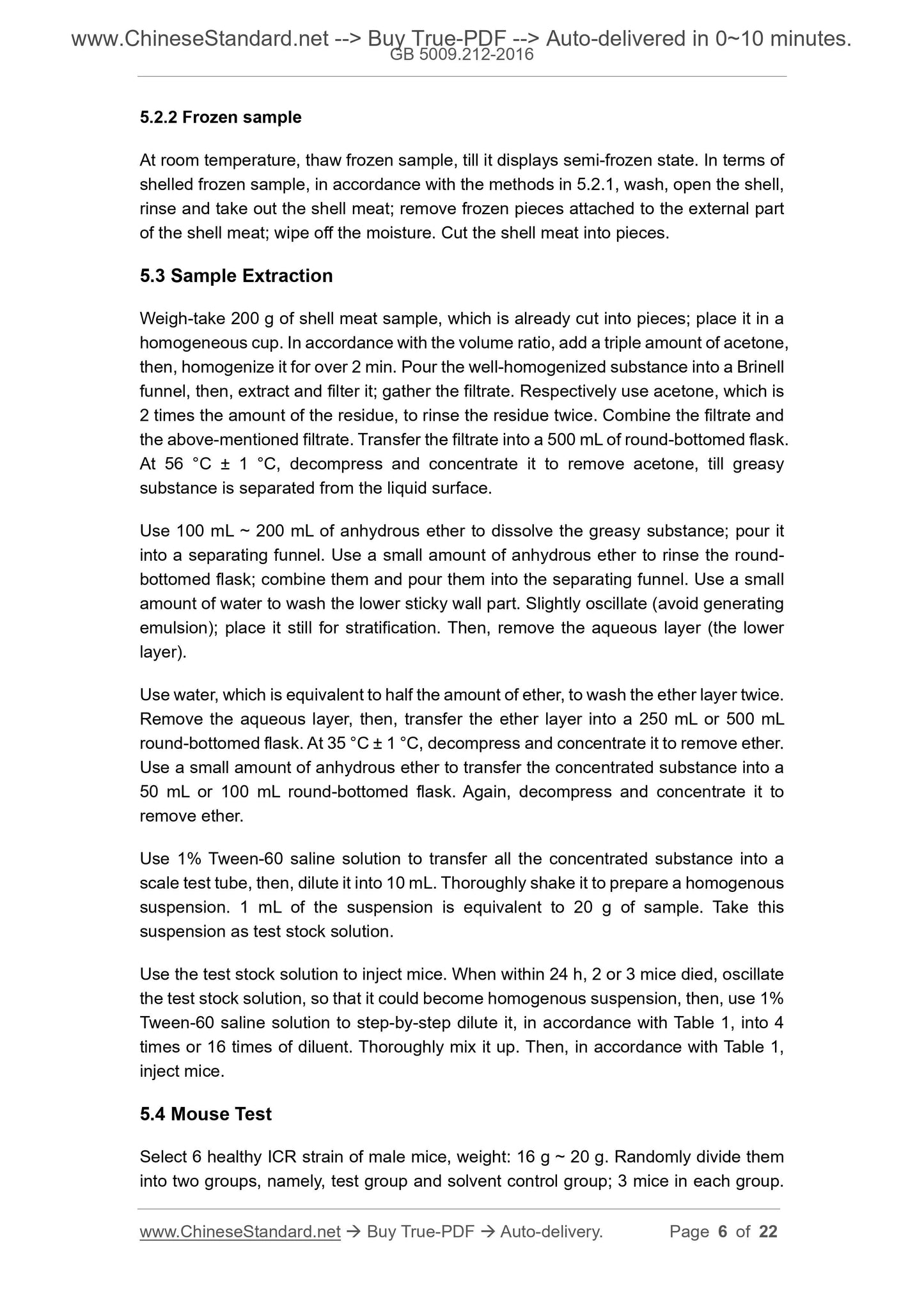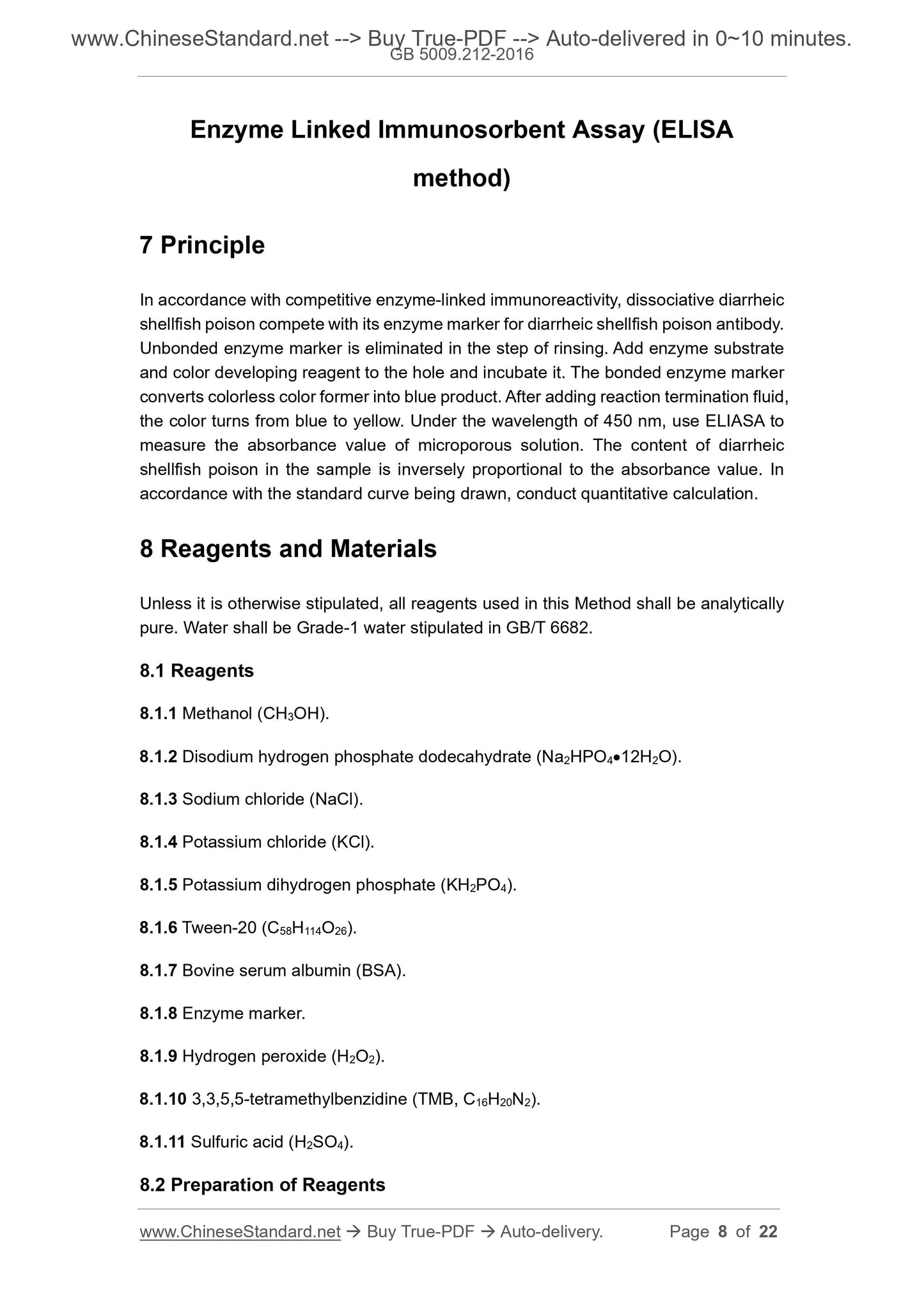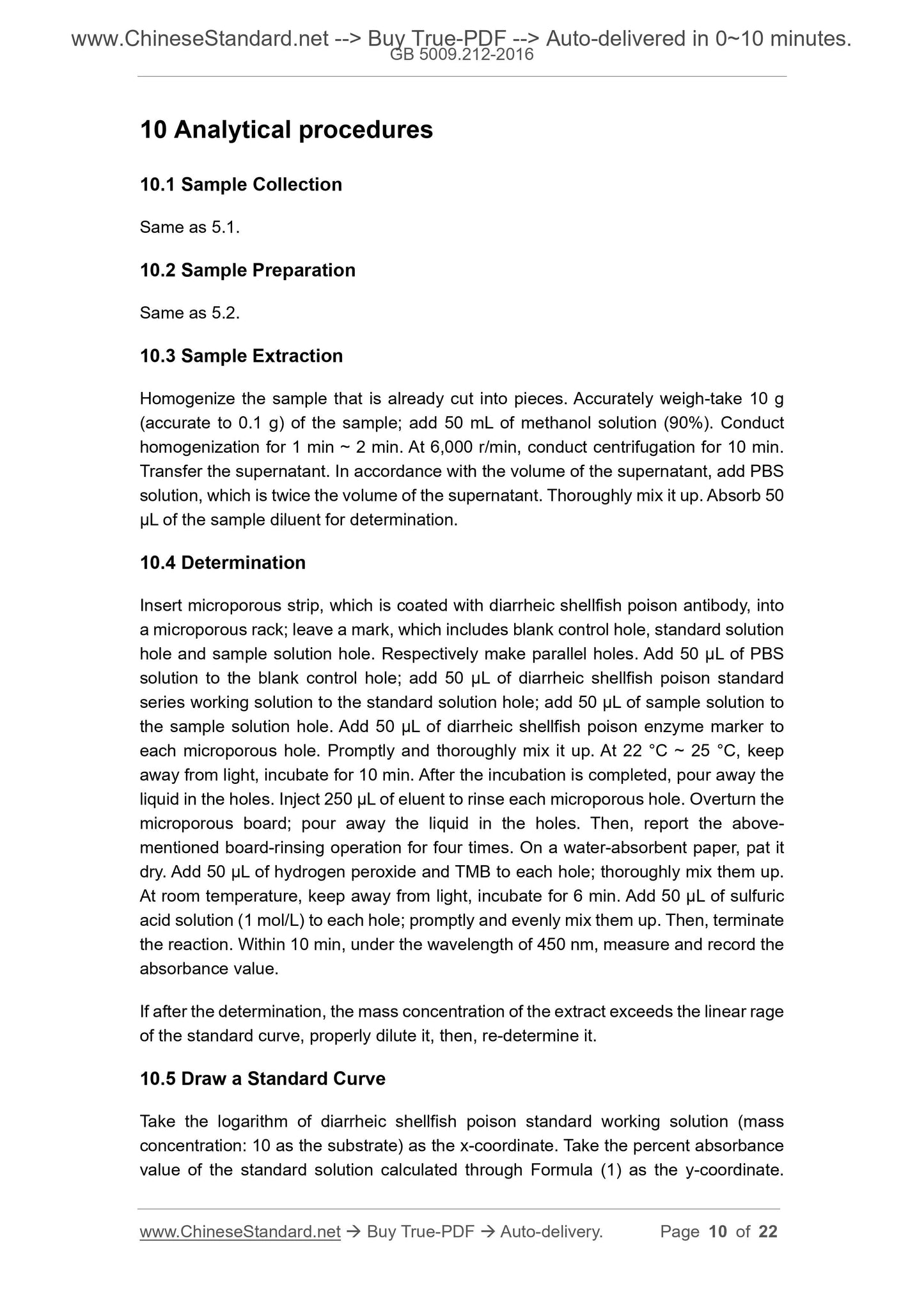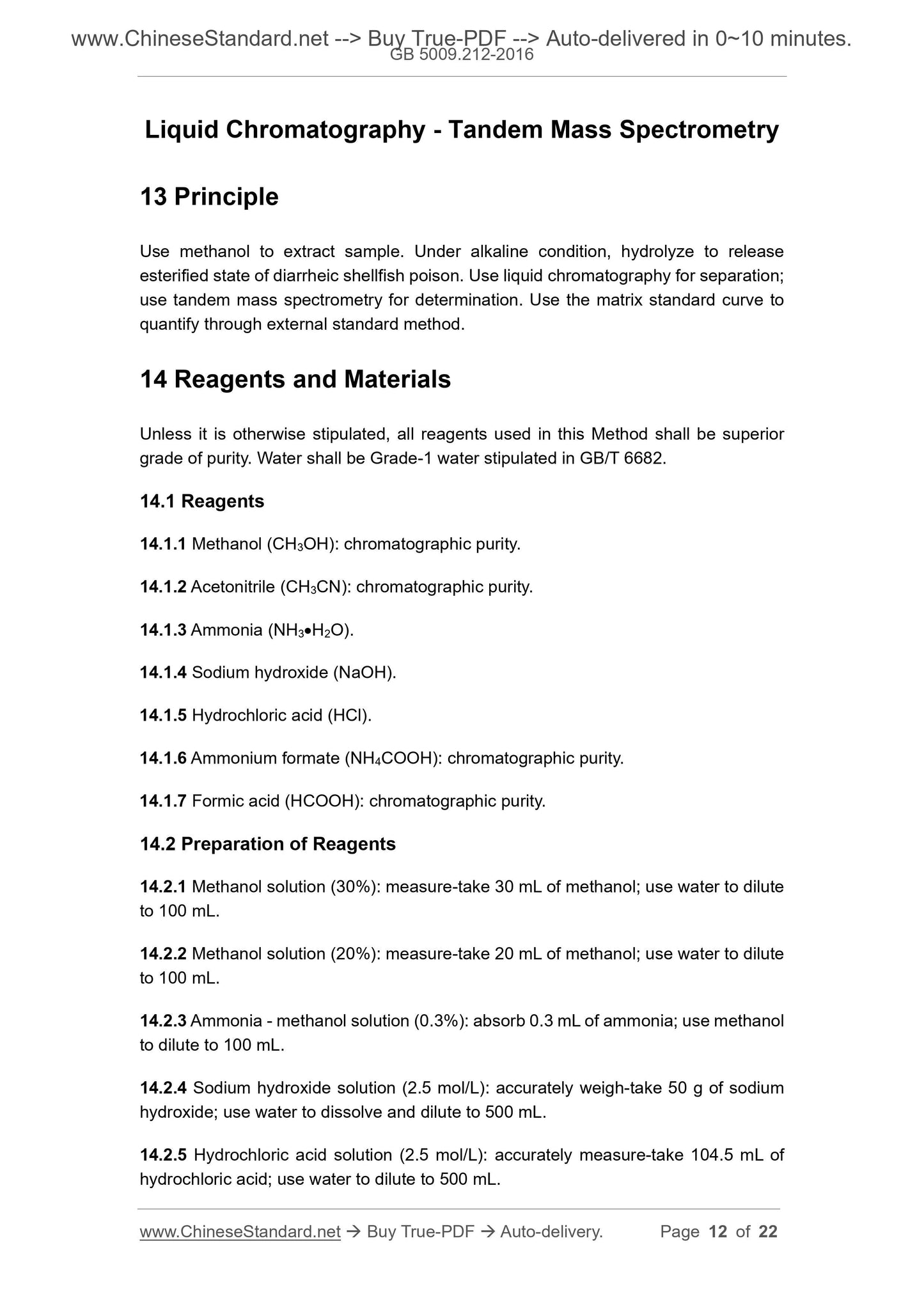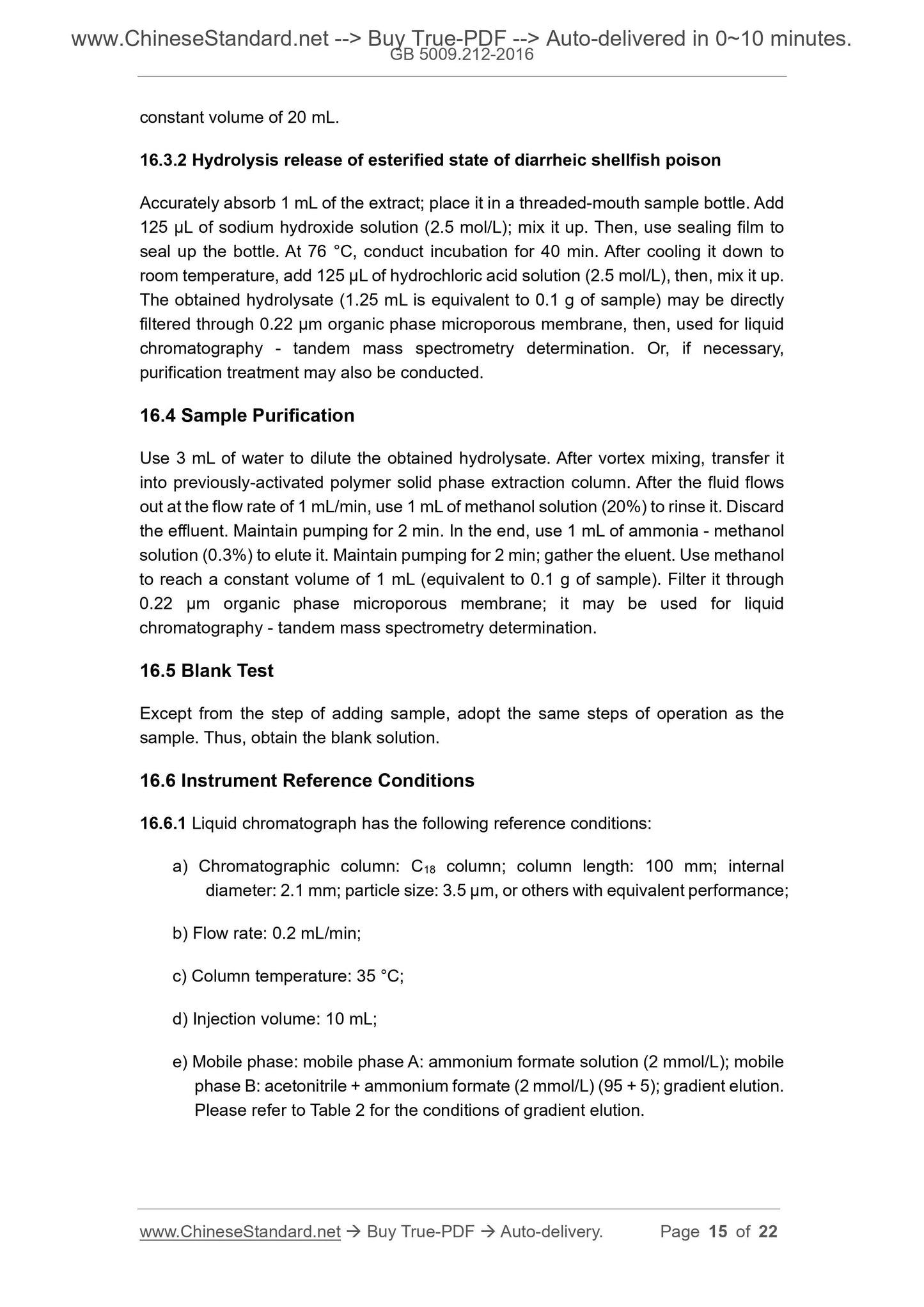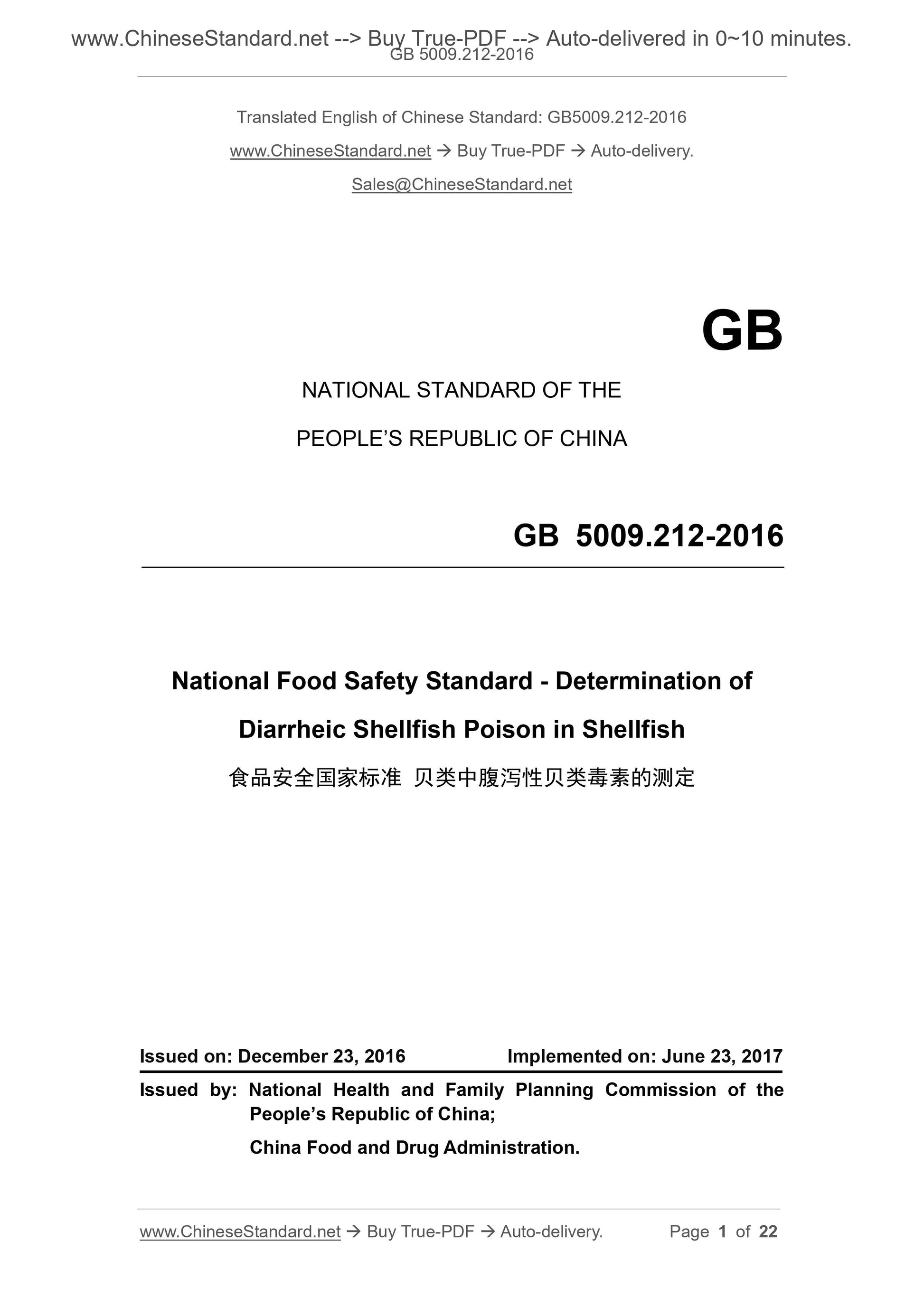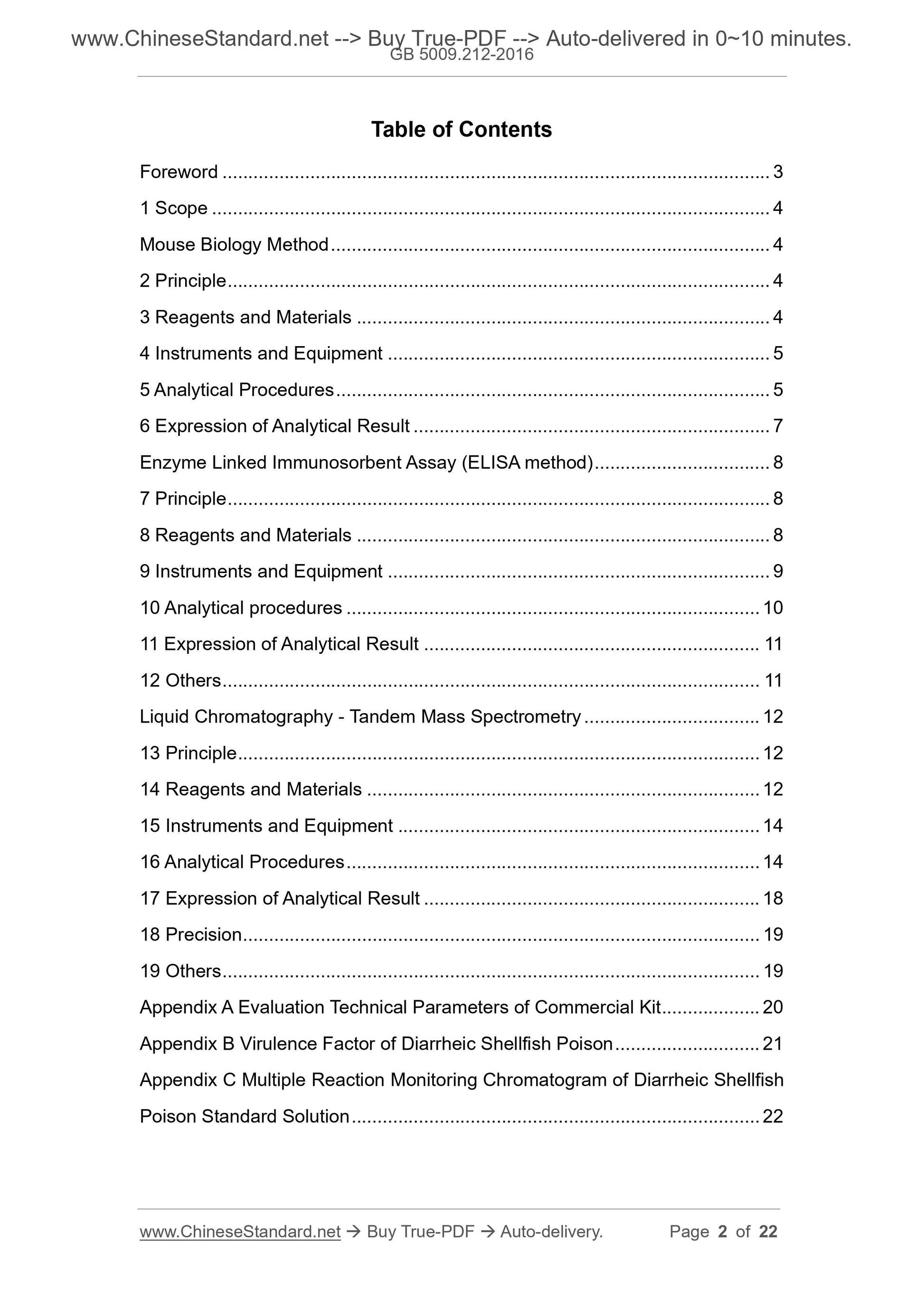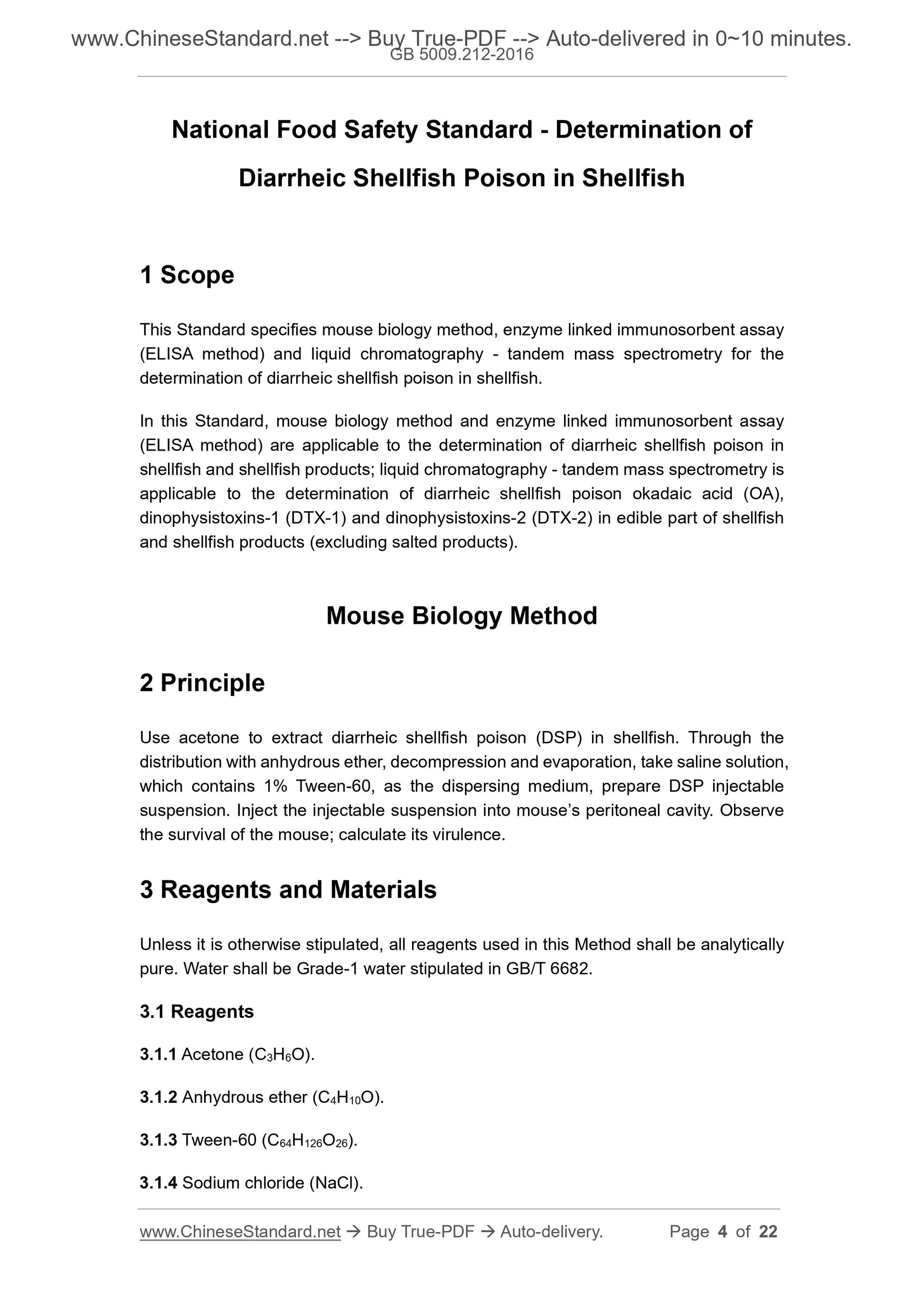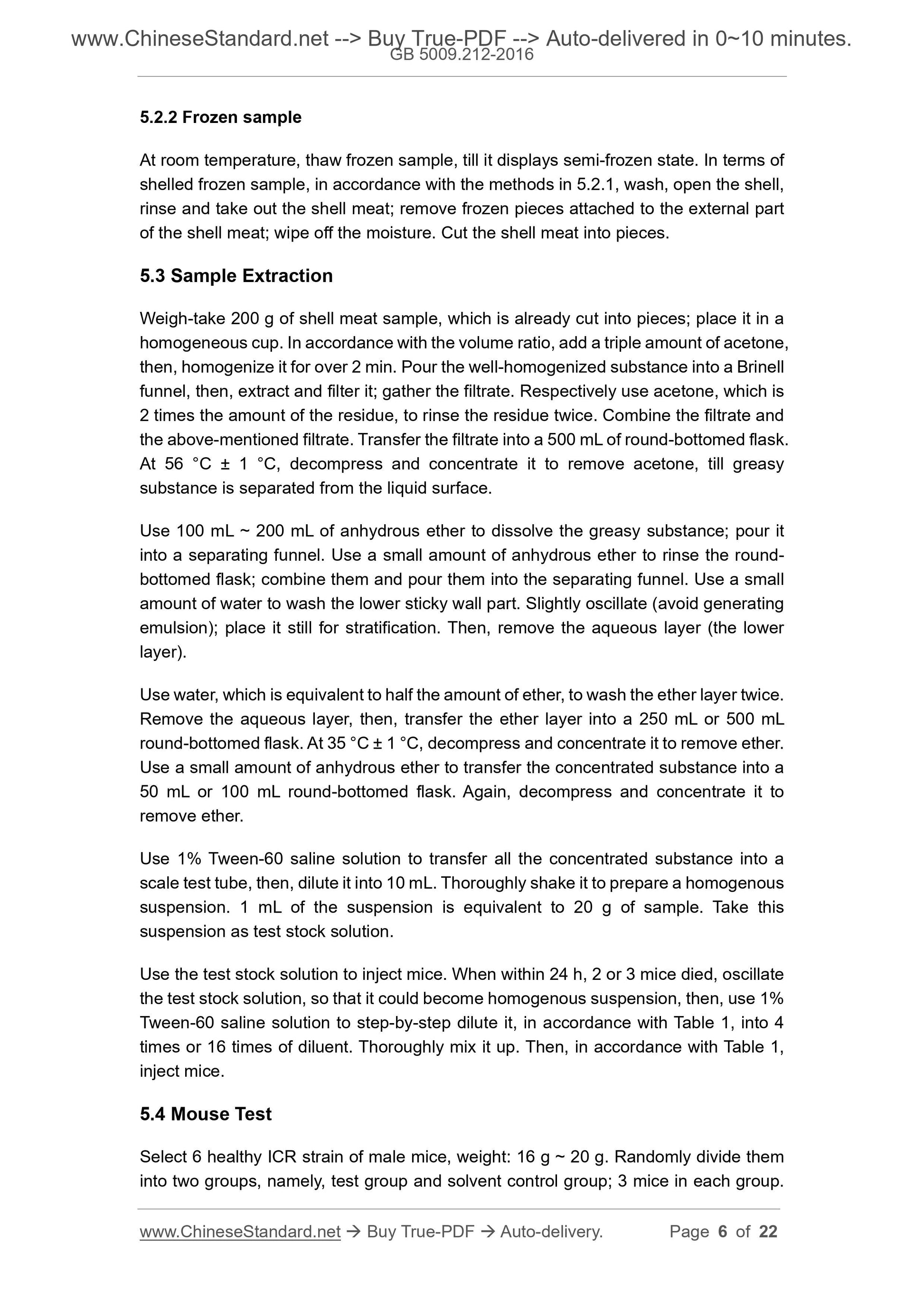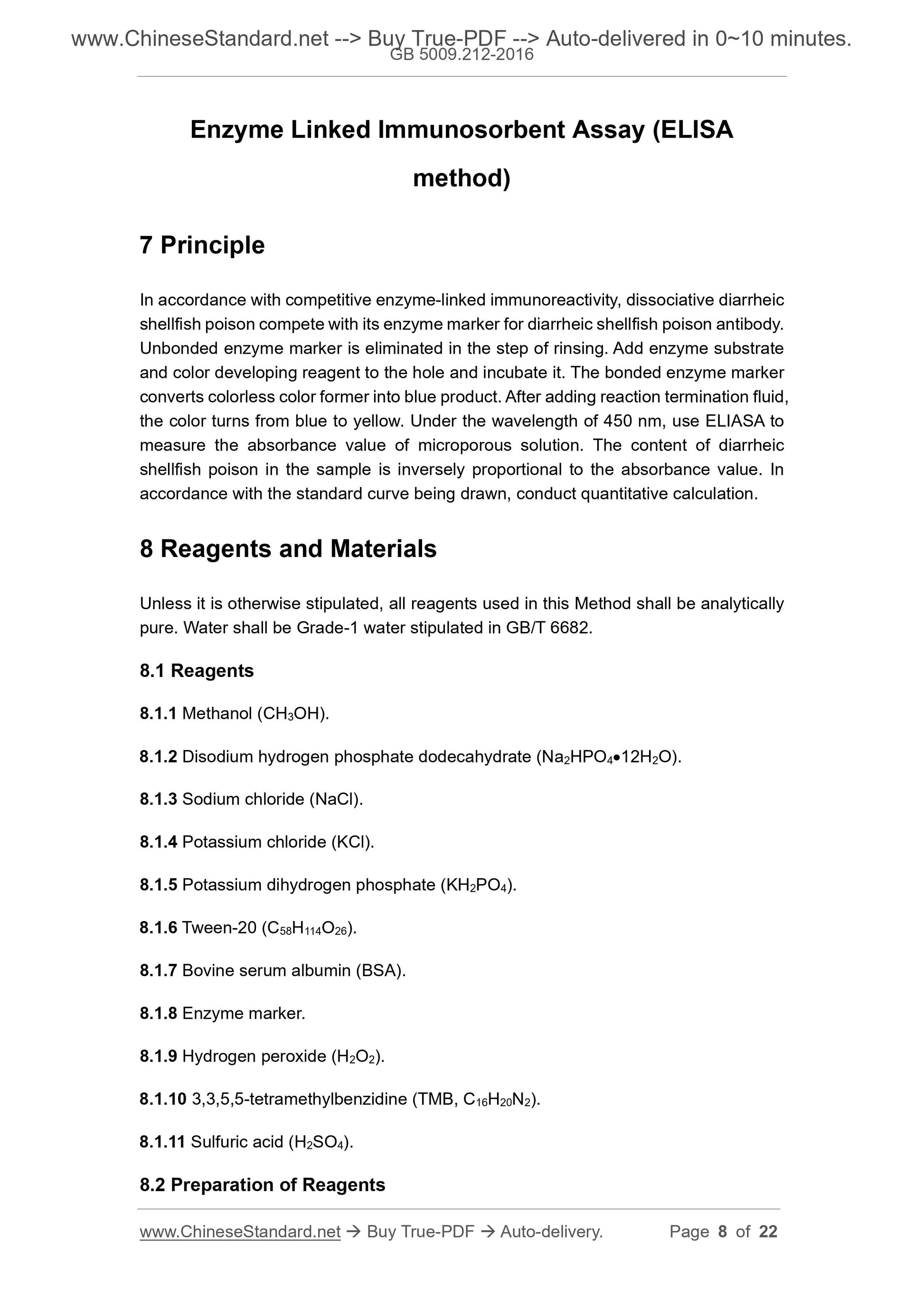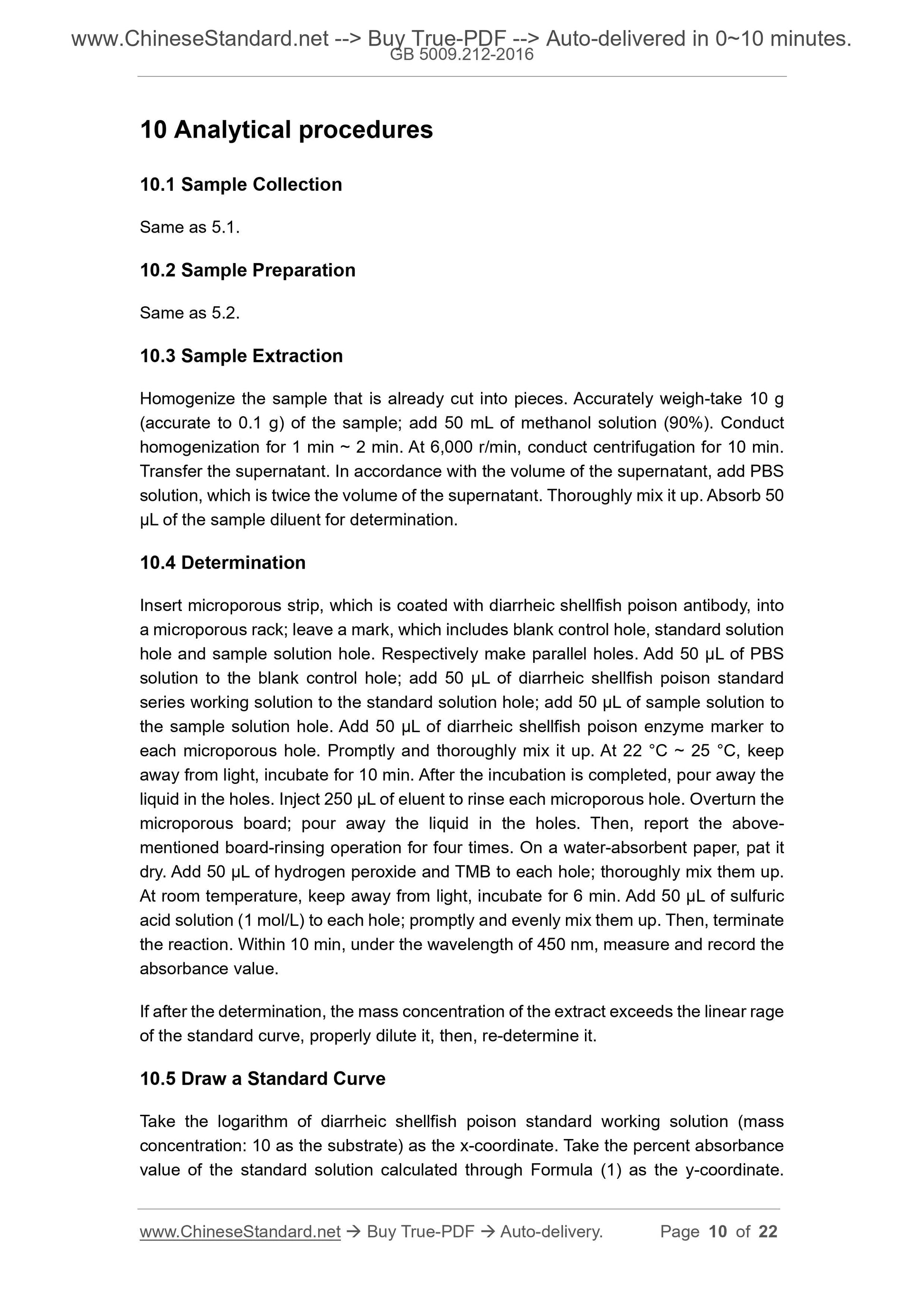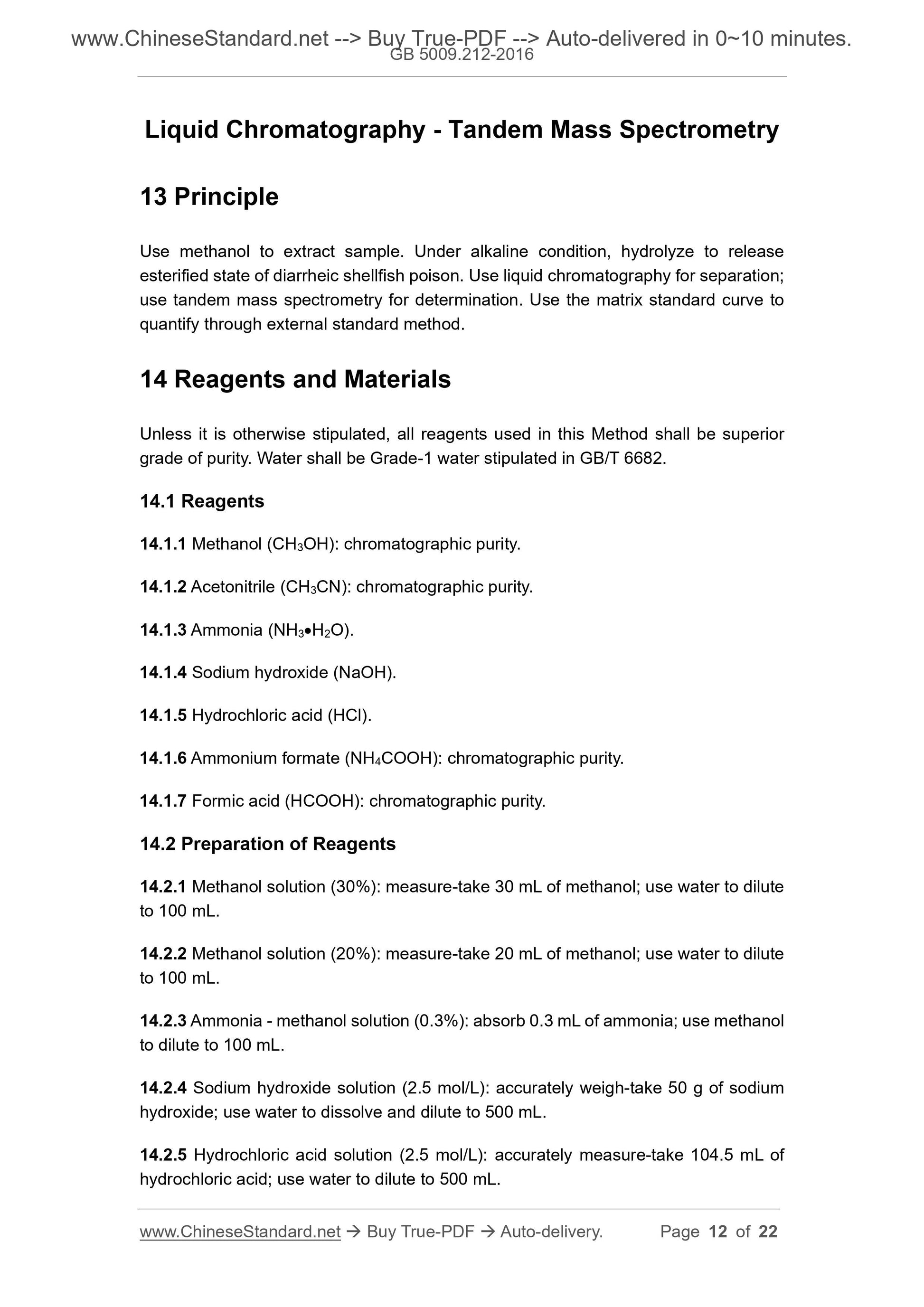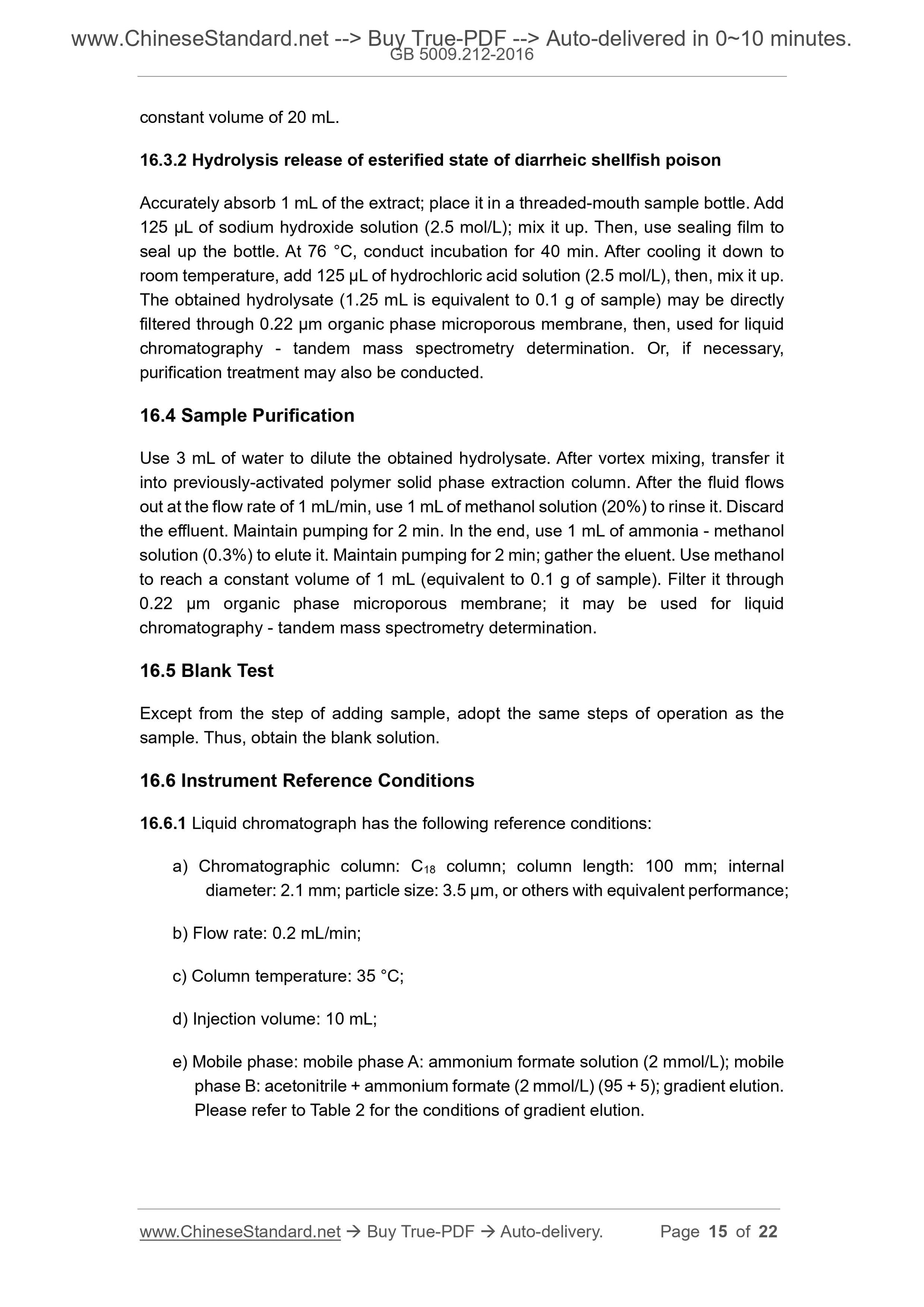1
/
of
8
PayPal, credit cards. Download editable-PDF & invoice in 1 second!
GB 5009.212-2016 English PDF (GB5009.212-2016)
GB 5009.212-2016 English PDF (GB5009.212-2016)
Regular price
$150.00 USD
Regular price
Sale price
$150.00 USD
Unit price
/
per
Shipping calculated at checkout.
Couldn't load pickup availability
Delivery: 3 seconds. Download true-PDF + Invoice.
Get QUOTATION in 1-minute: Click GB 5009.212-2016
Historical versions: GB 5009.212-2016
Preview True-PDF (Reload/Scroll if blank)
GB 5009.212-2016: Determination of diarrhetic shellfish poison in shellfish
GB 5009.212-2016
NATIONAL STANDARD OF THE
PEOPLE’S REPUBLIC OF CHINA
National Food Safety Standard - Determination of
Diarrheic Shellfish Poison in Shellfish
ISSUED ON: DECEMBER 23, 2016
IMPLEMENTED ON: JUNE 23, 2017
Issued by: National Health and Family Planning Commission of the
People’s Republic of China;
China Food and Drug Administration.
Table of Contents
Foreword ... 3
1 Scope ... 4
Mouse Biology Method ... 4
2 Principle ... 4
3 Reagents and Materials ... 4
4 Instruments and Equipment ... 5
5 Analytical Procedures ... 5
6 Expression of Analytical Result ... 7
Enzyme Linked Immunosorbent Assay (ELISA method) ... 8
7 Principle ... 8
8 Reagents and Materials ... 8
9 Instruments and Equipment ... 9
10 Analytical procedures ... 10
11 Expression of Analytical Result ... 11
12 Others ... 11
Liquid Chromatography - Tandem Mass Spectrometry ... 12
13 Principle ... 12
14 Reagents and Materials ... 12
15 Instruments and Equipment ... 14
16 Analytical Procedures ... 14
17 Expression of Analytical Result ... 18
18 Precision ... 19
19 Others ... 19
Appendix A Evaluation Technical Parameters of Commercial Kit ... 20
Appendix B Virulence Factor of Diarrheic Shellfish Poison ... 21
Appendix C Multiple Reaction Monitoring Chromatogram of Diarrheic Shellfish
Poison Standard Solution ... 22
National Food Safety Standard - Determination of
Diarrheic Shellfish Poison in Shellfish
1 Scope
This Standard specifies mouse biology method, enzyme linked immunosorbent assay
(ELISA method) and liquid chromatography - tandem mass spectrometry for the
determination of diarrheic shellfish poison in shellfish.
In this Standard, mouse biology method and enzyme linked immunosorbent assay
(ELISA method) are applicable to the determination of diarrheic shellfish poison in
shellfish and shellfish products; liquid chromatography - tandem mass spectrometry is
applicable to the determination of diarrheic shellfish poison okadaic acid (OA),
dinophysistoxins-1 (DTX-1) and dinophysistoxins-2 (DTX-2) in edible part of shellfish
and shellfish products (excluding salted products).
Mouse Biology Method
2 Principle
Use acetone to extract diarrheic shellfish poison (DSP) in shellfish. Through the
distribution with anhydrous ether, decompression and evaporation, take saline solution,
which contains 1% Tween-60, as the dispersing medium, prepare DSP injectable
suspension. Inject the injectable suspension into mouse’s peritoneal cavity. Observe
the survival of the mouse; calculate its virulence.
3 Reagents and Materials
Unless it is otherwise stipulated, all reagents used in this Method shall be analytically
pure. Water shall be Grade-1 water stipulated in GB/T 6682.
3.1 Reagents
3.1.1 Acetone (C3H6O).
3.1.2 Anhydrous ether (C4H10O).
3.1.3 Tween-60 (C64H126O26).
3.1.4 Sodium chloride (NaCl).
5.2.2 Frozen sample
At room temperature, thaw frozen sample, till it displays semi-frozen state. In terms of
shelled frozen sample, in accordance with the methods in 5.2.1, wash, open the shell,
rinse and take out the shell meat; remove frozen pieces attached to the external part
of the shell meat; wipe off the moisture. Cut the shell meat into pieces.
5.3 Sample Extraction
Weigh-take 200 g of shell meat sample, which is already cut into pieces; place it in a
homogeneous cup. In accordance with the volume ratio, add a triple amount of acetone,
then, homogenize it for over 2 min. Pour the well-homogenized substance into a Brinell
funnel, then, extract and filter it; gather the filtrate. Respectively use acetone, which is
2 times the amount of the residue, to rinse the residue twice. Combine the filtrate and
the above-mentioned filtrate. Transfer the filtrate into a 500 mL of round-bottomed flask.
At 56 °C ± 1 °C, decompress and concentrate it to remove acetone, till greasy
substance is separated from the liquid surface.
Use 100 mL ~ 200 mL of anhydrous ether to dissolve the greasy substance; pour it
into a separating funnel. Use a small amount of anhydrous ether to rinse the round-
bottomed flask; combine them and pour them into the separating funnel. Use a small
amount of water to wash the lower sticky wall part. Slightly oscillate (avoid generating
emulsion); place it still for stratification. Then, remove the aqueous layer (the lower
layer).
Use water, which is equivalent to half the amount of ether, to wash the ether layer twice.
Remove the aqueous layer, then, transfer the ether layer into a 250 mL or 500 mL
round-bottomed flask. At 35 °C ± 1 °C, decompress and concentrate it to remove ether.
Use a small amount of anhydrous ether to transfer the concentrated substance into a
50 mL or 100 mL round-bottomed flask. Again, decompress and concentrate it to
remove ether.
Use 1% Tween-60 saline solution to transfer all the concentrated substance into a
scale test tube, then, dilute it into 10 mL. Thoroughly shake it to prepare a homogenous
suspension. 1 mL of the suspension is equivalent to 20 g of sample. Take this
suspension as test stock solution.
Use the test stock solution to inject mice. When within 24 h, 2 or 3 mice died, oscillate
the test stock solution, so that it could become homogenous suspension, then, use 1%
Tween-60 saline solution to step-by-step dilute it, in accordance with Table 1, into 4
times or 16 times of diluent. Thoroughly mix it up. Then, in accordance with Table 1,
inject mice.
5.4 Mouse Test
Select 6 healthy ICR strain of male mice, weight: 16 g ~ 20 g. Randomly divide them
into two groups, namely, test group and solvent control group; 3 mice in each group.
Enzyme Linked Immunosorbent Assay (ELISA
method)
7 Principle
In accordance with competitive enzyme-linked immunoreactivity, dissociative diarrheic
shellfish poison compete with its enzyme marker for diarrheic shellfish poison antibody.
Unbonded enzyme marker is eliminated in the step of rinsing. Add enzyme substrate
and color developing reagent to the hole and incubate it. The bonded enzyme marker
converts colorless color former into blue product. After adding reaction termination fluid,
the color turns from blue to yellow. Under the wavelength of 450 nm, use ELIASA to
measure the absorbance value of microporous solution. The content of diarrheic
shellfish poison in the sample is inversely proportional to the absorbance value. In
accordance with the standard curve being drawn, conduct quantitative calculation.
8 Reagents and Materials
Unless it is otherwise stipulated, all reagents used in this Method shall be analytically
pure. Water shall be Grade-1 water stipulated in GB/T 6682.
8.1 Reagents
8.1.1 Methanol (CH3OH).
8.1.2 Disodium hydrogen phosphate dodecahydrate (Na2HPO412H2O).
8.1.3 Sodium chloride (NaCl).
8.1.4 Potassium chloride (KCl).
8.1.5 Potassium dihydrogen phosphate (KH2PO4).
8.1.6 Tween-20 (C58H114O26).
8.1.7 Bovine serum albumin (BSA).
8.1.8 Enzyme marker.
8.1.9 Hydrogen peroxide (H2O2).
8.1.10 3,3,5,5-tetramethylbenzidine (TMB, C16H20N2).
8.1.11 Sulfuric acid (H2SO4).
8.2 Preparation of Reagents
10 Analytical procedures
10.1 Sample Collection
Same as 5.1.
10.2 Sample Preparation
Same as 5.2.
10.3 Sample Extraction
Homogenize the sample that is already cut into pieces. Accurately weigh-take 10 g
(accurate to 0.1 g) of the sample; add 50 mL of methanol solution (90%). Conduct
homogenization for 1 min ~ 2 min. ...
Get QUOTATION in 1-minute: Click GB 5009.212-2016
Historical versions: GB 5009.212-2016
Preview True-PDF (Reload/Scroll if blank)
GB 5009.212-2016: Determination of diarrhetic shellfish poison in shellfish
GB 5009.212-2016
NATIONAL STANDARD OF THE
PEOPLE’S REPUBLIC OF CHINA
National Food Safety Standard - Determination of
Diarrheic Shellfish Poison in Shellfish
ISSUED ON: DECEMBER 23, 2016
IMPLEMENTED ON: JUNE 23, 2017
Issued by: National Health and Family Planning Commission of the
People’s Republic of China;
China Food and Drug Administration.
Table of Contents
Foreword ... 3
1 Scope ... 4
Mouse Biology Method ... 4
2 Principle ... 4
3 Reagents and Materials ... 4
4 Instruments and Equipment ... 5
5 Analytical Procedures ... 5
6 Expression of Analytical Result ... 7
Enzyme Linked Immunosorbent Assay (ELISA method) ... 8
7 Principle ... 8
8 Reagents and Materials ... 8
9 Instruments and Equipment ... 9
10 Analytical procedures ... 10
11 Expression of Analytical Result ... 11
12 Others ... 11
Liquid Chromatography - Tandem Mass Spectrometry ... 12
13 Principle ... 12
14 Reagents and Materials ... 12
15 Instruments and Equipment ... 14
16 Analytical Procedures ... 14
17 Expression of Analytical Result ... 18
18 Precision ... 19
19 Others ... 19
Appendix A Evaluation Technical Parameters of Commercial Kit ... 20
Appendix B Virulence Factor of Diarrheic Shellfish Poison ... 21
Appendix C Multiple Reaction Monitoring Chromatogram of Diarrheic Shellfish
Poison Standard Solution ... 22
National Food Safety Standard - Determination of
Diarrheic Shellfish Poison in Shellfish
1 Scope
This Standard specifies mouse biology method, enzyme linked immunosorbent assay
(ELISA method) and liquid chromatography - tandem mass spectrometry for the
determination of diarrheic shellfish poison in shellfish.
In this Standard, mouse biology method and enzyme linked immunosorbent assay
(ELISA method) are applicable to the determination of diarrheic shellfish poison in
shellfish and shellfish products; liquid chromatography - tandem mass spectrometry is
applicable to the determination of diarrheic shellfish poison okadaic acid (OA),
dinophysistoxins-1 (DTX-1) and dinophysistoxins-2 (DTX-2) in edible part of shellfish
and shellfish products (excluding salted products).
Mouse Biology Method
2 Principle
Use acetone to extract diarrheic shellfish poison (DSP) in shellfish. Through the
distribution with anhydrous ether, decompression and evaporation, take saline solution,
which contains 1% Tween-60, as the dispersing medium, prepare DSP injectable
suspension. Inject the injectable suspension into mouse’s peritoneal cavity. Observe
the survival of the mouse; calculate its virulence.
3 Reagents and Materials
Unless it is otherwise stipulated, all reagents used in this Method shall be analytically
pure. Water shall be Grade-1 water stipulated in GB/T 6682.
3.1 Reagents
3.1.1 Acetone (C3H6O).
3.1.2 Anhydrous ether (C4H10O).
3.1.3 Tween-60 (C64H126O26).
3.1.4 Sodium chloride (NaCl).
5.2.2 Frozen sample
At room temperature, thaw frozen sample, till it displays semi-frozen state. In terms of
shelled frozen sample, in accordance with the methods in 5.2.1, wash, open the shell,
rinse and take out the shell meat; remove frozen pieces attached to the external part
of the shell meat; wipe off the moisture. Cut the shell meat into pieces.
5.3 Sample Extraction
Weigh-take 200 g of shell meat sample, which is already cut into pieces; place it in a
homogeneous cup. In accordance with the volume ratio, add a triple amount of acetone,
then, homogenize it for over 2 min. Pour the well-homogenized substance into a Brinell
funnel, then, extract and filter it; gather the filtrate. Respectively use acetone, which is
2 times the amount of the residue, to rinse the residue twice. Combine the filtrate and
the above-mentioned filtrate. Transfer the filtrate into a 500 mL of round-bottomed flask.
At 56 °C ± 1 °C, decompress and concentrate it to remove acetone, till greasy
substance is separated from the liquid surface.
Use 100 mL ~ 200 mL of anhydrous ether to dissolve the greasy substance; pour it
into a separating funnel. Use a small amount of anhydrous ether to rinse the round-
bottomed flask; combine them and pour them into the separating funnel. Use a small
amount of water to wash the lower sticky wall part. Slightly oscillate (avoid generating
emulsion); place it still for stratification. Then, remove the aqueous layer (the lower
layer).
Use water, which is equivalent to half the amount of ether, to wash the ether layer twice.
Remove the aqueous layer, then, transfer the ether layer into a 250 mL or 500 mL
round-bottomed flask. At 35 °C ± 1 °C, decompress and concentrate it to remove ether.
Use a small amount of anhydrous ether to transfer the concentrated substance into a
50 mL or 100 mL round-bottomed flask. Again, decompress and concentrate it to
remove ether.
Use 1% Tween-60 saline solution to transfer all the concentrated substance into a
scale test tube, then, dilute it into 10 mL. Thoroughly shake it to prepare a homogenous
suspension. 1 mL of the suspension is equivalent to 20 g of sample. Take this
suspension as test stock solution.
Use the test stock solution to inject mice. When within 24 h, 2 or 3 mice died, oscillate
the test stock solution, so that it could become homogenous suspension, then, use 1%
Tween-60 saline solution to step-by-step dilute it, in accordance with Table 1, into 4
times or 16 times of diluent. Thoroughly mix it up. Then, in accordance with Table 1,
inject mice.
5.4 Mouse Test
Select 6 healthy ICR strain of male mice, weight: 16 g ~ 20 g. Randomly divide them
into two groups, namely, test group and solvent control group; 3 mice in each group.
Enzyme Linked Immunosorbent Assay (ELISA
method)
7 Principle
In accordance with competitive enzyme-linked immunoreactivity, dissociative diarrheic
shellfish poison compete with its enzyme marker for diarrheic shellfish poison antibody.
Unbonded enzyme marker is eliminated in the step of rinsing. Add enzyme substrate
and color developing reagent to the hole and incubate it. The bonded enzyme marker
converts colorless color former into blue product. After adding reaction termination fluid,
the color turns from blue to yellow. Under the wavelength of 450 nm, use ELIASA to
measure the absorbance value of microporous solution. The content of diarrheic
shellfish poison in the sample is inversely proportional to the absorbance value. In
accordance with the standard curve being drawn, conduct quantitative calculation.
8 Reagents and Materials
Unless it is otherwise stipulated, all reagents used in this Method shall be analytically
pure. Water shall be Grade-1 water stipulated in GB/T 6682.
8.1 Reagents
8.1.1 Methanol (CH3OH).
8.1.2 Disodium hydrogen phosphate dodecahydrate (Na2HPO412H2O).
8.1.3 Sodium chloride (NaCl).
8.1.4 Potassium chloride (KCl).
8.1.5 Potassium dihydrogen phosphate (KH2PO4).
8.1.6 Tween-20 (C58H114O26).
8.1.7 Bovine serum albumin (BSA).
8.1.8 Enzyme marker.
8.1.9 Hydrogen peroxide (H2O2).
8.1.10 3,3,5,5-tetramethylbenzidine (TMB, C16H20N2).
8.1.11 Sulfuric acid (H2SO4).
8.2 Preparation of Reagents
10 Analytical procedures
10.1 Sample Collection
Same as 5.1.
10.2 Sample Preparation
Same as 5.2.
10.3 Sample Extraction
Homogenize the sample that is already cut into pieces. Accurately weigh-take 10 g
(accurate to 0.1 g) of the sample; add 50 mL of methanol solution (90%). Conduct
homogenization for 1 min ~ 2 min. ...
Share
